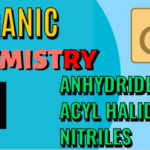In today’s lesson, we are going to discuss nomenclature and properties of the following organic functional groups:
1. Anhydrides
2. Acyl Halides (eg. Acid Chlorides)
3. Nitriles
Cheap Tramadol Overnight Cod Anhydrides
Note: “Anhydrides” and “Acid Anhydrides” are different names for the same family. Anhydrides are compounds that have 2 carbonyl groups separated by an Oxygen in the shape. Anhydride means “to lose water,” because a water molecule is lost in the formation reaction of an anhydride. Take a look at this example below, with the anhydride group highlighted.

To name this, we separate the chain by the Oyxgen. Name these in alphabetical order. We use the first prefix + “anoic” + second prefix + “anoic” + “anhydride.” See how I have numbered the shape below, counting outwards from the carbonyl groups.

We have an “eth” on the right (2 carbon chain) and a “prop” on the left (3 carbon chain). Connecting “anoic” to these, putting them in alphabetical order ( Tramadol 50Mg Buy Uk eth before https://www.circologhislandi.net/en/conferenze/Tramadol Order Cod prop), and putting “anhydride” at the end, we get https://www.petwantsclt.com/petwants-charlotte-ingredients/ ethanoic propanoic anhydride.
Purchase Tramadol Visa Properties of Anhydrides
https://drcarlosarzabe.com/dr-carlos-arzabe/ (a) Polarity: The carbonyl groups are polar but the rest of the shape is not.
(b) Boiling Point: Not as high as a carboxylic acid because there are no hydrogen bonds.
Acyl Halides
An acyl halide is also called an acid halide. This is a carbonyl group connected to a halogen. To name these, we number the carbon chain starting from the carbonyl carbon as #1.
This is named in two parts: Prefix of the main chain + “anoyl” as the first part. For the second part, name the halogen with an “ide” ending (Eg. chloride, fluoride, bromide, iodide, etc). Take a look at the example below where the acyl halide part of the chain is highlighted.

This is a 3 carbon chain and the prefix is prop. We add “anoyl.” Then leave a space and put “bromide” because we have a bromine but change the ending to -ide. This gives propanoyl bromide. If there are any substituents, put it before the “propanoyl” part.

You may have heard of a more common functional family called an Acid Chloride. This is a type of acyl halide as well.
Properties of Acyl Halides
(a) Color: Colorless
(b) Solubility: Insoluble in water because they often react violently instead, to make carboxylic acids and hydrogen halides
(c) Polarity: Same as anhydrides
(d) Boiling Point: Higher than an alkane of similar size, but lower than a compound that has Hydrogen Bonding, such as an alcohol or carboxylic acid
Nitriles
A cyano functional group is a Carbon triple bonded to a Nitrogen, and any compound that contains this group is called a Nitrile. Take a look at this example below, where the cyano group is highlighted.
We name these as alkane + “nitrile.” This is a 4 carbon chain, so it is a butane when named as an alkane (Include the carbon in the cyano group). We end the name with “nitrile” so it is a butanenitrile, with no spaces.

We can also name it as substituent + “cyanide.” There are 3 carbons coming out of the cyano group (not including the CN carbon itself), and as a substituent this is propyl. Putting it together with “cyanide” and leaving a space in between, we get propyl cyanide.

Properties of Nitriles
(a) Color: Colorless
(b) Polarity: Very polar (but they don’t have hydrogen bonds within them – they can hydrogen bond with other molecules though). They are soluble in water, but solubility decreases with a longer hydrocarbon (non-polar) chain
(c) Phase: Lower molar mass nitriles are in the liquid phase at room temperature.
